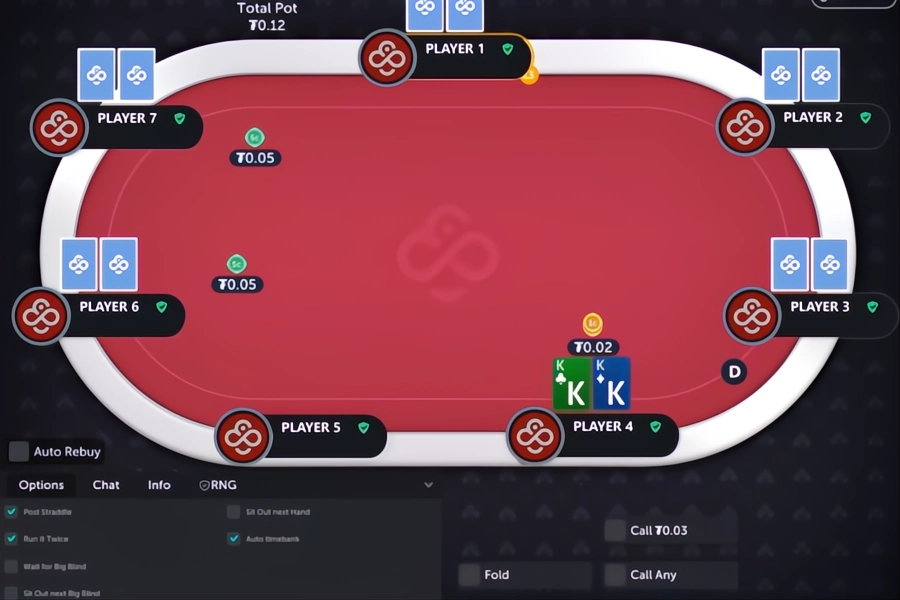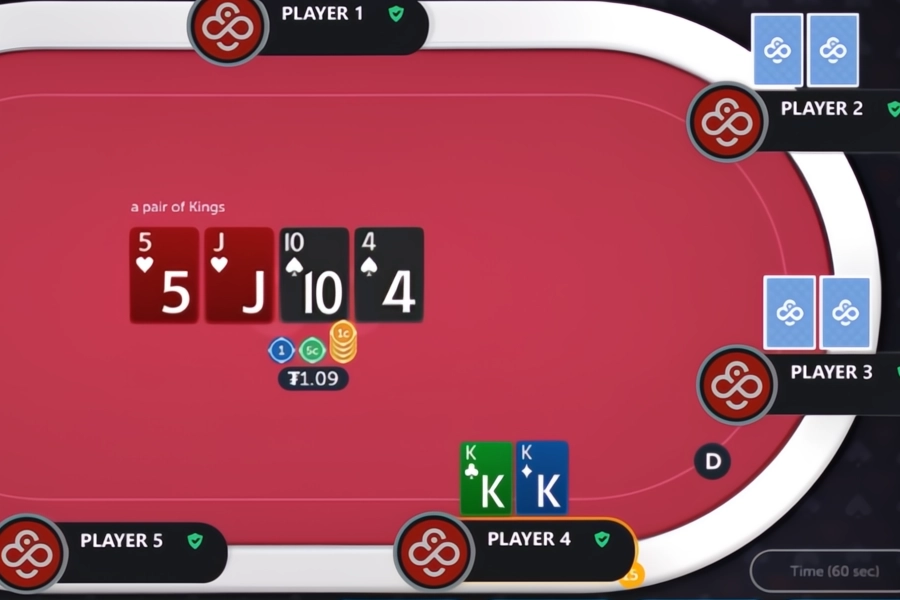Last Updated: 26 September 2025
How to Deal Texas Hold’em Poker: A Step-by-Step Guide
Learning how to deal in poker is the first step to hosting your own poker game. The role of the poker dealer cannot be overstated in a poker game. In fact, a game cannot run without a dealer, and a skillful dealer can make all the difference. In this guide, we are going to teach ... How to Deal Texas Hold’em Poker: A Step-by-Step Guide
Guides
Learning how to deal in poker is the first step to hosting your own poker game. The role of the poker dealer cannot be overstated in a poker game. In fact, a game cannot run without a dealer, and a skillful dealer can make all the difference.
In this guide, we are going to teach you how to deal cards in Texas Hold’em Poker, how to assign the button, handle chips, and determine winners in each poker hand. Keep reading and learn how to deal in poker in a simple and straightforward step-by-step guide.
Step 1: Shuffle Up & Deal
Before a Texas Hold’em Poker game can start, you must assign the dealer button to one player at the table. Once assigned, the dealer button will move clockwise around the table after each hand so that every player gets the button once per orbit. The dealer button is first assigned by dealing one card face-up to each player. The player with the highest card gets the button.

When the dealer button is assigned, the two players to the immediate left of the dealer will have to post the small blind and the big blind. Before you can start dealing the cards, you need to make sure these bets are in the pot. If ante bets are in play, make sure that every player has posted their ante or that the big blind has also posted the big blind ante.
For example, playing in an online poker game with blinds at 500/1000, the player to the immediate left of the dealer button would post a 500 chip small blind, while the next player would post the 1000 chip big blind. If ante bets are in play, all players at the table would need to post a 100 chip ante. Alternatively, if the big blind ante rule is in play, the big blind would post a 1000 chip ante bet for the entire table.
Once all the mandatory bets are in place, you need to shuffle the deck to ensure randomness and safety. In most games, the dealer is required to shuffle and cut the deck three times before dealing can start. Using different shuffling techniques can help enhance the feeling of safety among the players.
Now that the cards are properly shuffled, you can start dealing. Starting with the small blind, pitch each player at the table one card face-down, going in a clockwise order. Once you reach the dealer button, all players will have their first hole card. Repeat the process in the same order, ensuring that every player has both of their hole cards to start with.
Step 2: The Flop
Once all the hole cards have been dealt, players will get to act on their hands in the first betting round, also known as preflop. In this betting round, action starts with the player positioned to the immediate left of the big blind, called “under the gun” (UTG).

Note: Position is quite important in poker! Here’s our poker position guide to help you understand its significance.
The player can take the following actions:
- Fold: Discard their hole cards and end participation in the hand. Once a player has folded, they can no longer win the pot, but will not be asked to commit any further chips to the pot either.
- Call: Match the value of the big blind and stay in the hand. If another player raises the bet subsequently, the player will once again have the option to fold, call, or raise the bet.
- Raise: Increase the size of the bet. In No Limit Texas Hold’em, each player can raise up to the size of their stack, since there are no betting limitations.
Once the first player has completed their action, other players take turns acting on their hands. Each player is given the same options until all players at the table have acted on their hand, with the big blind closing the action. A raise made by any player re-opens the action.
When all the preflop betting is completed, you can proceed to deal the first community cards, called the flop or the third street. The flop is made up of three community cards, for example A♦9♠4♣.
Burning a Card
Before dealing the flop, you will need to discard the top card from the deck and place it next to the community card area face-down. This process is called “burning” a card, and it is used as an extra precautionary measure to ensure the dealer is not cheating. Although card burning isn’t actually necessary in most games, players generally like to see the top card burnt.
Now that the top card is burnt, you can deal the top three cards from the deck in the community card area in the middle of the table, face-up. These three cards are the first community cards, and all the players at the table can use them to make their poker hands.
Once the flop has been dealt, players can once again act on their hands. This time around, the action starts with the small blind and moves around the table in a clockwise pattern. Players who folded their hole cards before the flop no longer have the option to play on the flop.
Step 3: The Turn
The flop betting action usually thins out the field and only leaves a few players in the hand. These players all proceed to see the next community card, which is called the turn. Before dealing the turn, make sure you burn the top card, as you did before dealing the flop.

After burning the top card, deal the next card in the community area, next to the flop, face-up. This turn card is the fourth of the five community cards that are dealt, and it, too, can be used by all remaining players to improve their poker hands. The turn card is a single card, such as 9♠.
Following the turn, players will once again have a chance to act on their hands. The next betting round follows the same betting pattern as the previous, with the small blind acting first and the dealer button acting last. Keep in mind that players who folded their cards in previous betting rounds no longer get to act.
Step 4: The River
Knowing how to deal in poker is all about consistency. The final community card is dealt in the same manner as the previous one, so you will need to repeat the process you used when dealing the turn.

Burn the top card from the deck before dealing the river. Once the card is burnt, deal the next card in the community card area, next to the flop and the turn face-up. This is the fifth community card, also known as the river. Once again, the river is made up of just a single card, such as 2♦.
When the river is dealt, the board will be completed. The five community cards in the middle of the table can be used by all remaining players, in addition to their hole cards, to make the best five-card poker hand.
Following the river, players get to act on their hands one last time. The last betting round starts with the small blind and ends with the dealer button. After the last betting round, active players are asked to reveal their cards.
Step 5: Awarding the Pot
After all the river betting has been completed, you will need to award the pot to the winner. If only one player is left in the hand, as all others have folded their cards, that player will automatically receive the entire pot.

If more than one player is still active in the hand, you will announce showdown, prompting the players to reveal their hole cards. If there was river betting, the player who made the last aggressive action (bet or raise) should reveal their cards first. If there was no action on the river, players reveal their cards in the same order they bet on the flop, turn, and river.
Once the hole cards are revealed, it is your job to determine the winner and award the pot correctly. Knowing how to deal in poker is not just about dealing the cards but also being able to recognize the winning hand quickly. In doing so, you will refer to the poker hand rankings table, which you should know by heart.
In the event that more than one player has the same poker hand, the hand ends in a split pot. In this situation, you will split the pot into two, three, or more equal parts, and award each player with one portion of the pot.
For example, imagine two players going to a showdown on a board of K♠J♥J♠7♣4♥. Once showdown is announced, the two players turn their hole cards over, revealing K♣Q♣ and K♦Q♥. Both players have two pairs, Kings and Jacks with a Queen kicker. Since their hands are identical, the pot is split down the middle, and each player receives one half of the pot.
Preparing for the Next Hand
A dealer who knows how to deal poker is able to transition between hands smoothly. To make this smooth transition, you will need to award the entire pot to the winner of the previous pot first, leaving no chips in the middle. When this is done, collect all the cards, including any hole cards that some payers may still be holding on to.
Now that you have made sure you have all the cards proceed to move the dealer button one stop to the left. This will prompt the players to the left of the button to post the small and big blind while you shuffle the cards.
Shuffle the cards using the same techniques you used for the previous hand. Make sure that the deck is well shuffled and there is no suspicion of cheating or foul play. Ensure that the blinds and antes are posted before dealing the next hand. Once you have gone through these steps, start dealing the hole cards and repeat the entire process all over again.
How Dealing Differs in Other Poker Variants
Knowing how to deal in Texas Hold’em Poker alone does not make you a versed poker dealer. The best dealers can deal up to several dozen poker variants, including those similar to Texas Hold’em, like Pot Limit Omaha, as well as many different games like Seven Card Stud, Five Card Draw, or Badugi.
Here is a quick look at how to deal in poker when dealing other poker variants:
- 6+ Hold’em: Also known as Short Deck Poker, 6+ Hold’em is played with a deck that includes no deuces, treys, fours, or fives. The dealing pattern is the same as in regular Texas Hold’em, but remember that a flush beats a full house in this one.
- Pot Limit Omaha: Dealing is similar to Texas Hold’em, except for the fact every player receives four hole cards instead of two. Community cards are dealt the same, but each player must use two hole cards and three community cards to make up their hand.
- Omaha Hi/Lo: The game is dealt in the same way as Pot Limit Omaha, but the pot is split between a high and a low hand at showdown. The low hand is the best five card hand with cards under an 8, without any pairs.
- Seven Card Stud: This game includes no hole cards. Each player receives a total of seven hole cards, three of which are dealt face-down. The game is typically played with a limit betting pattern, requiring a lot of adjustment.
- Five Card Draw: In this game, you will deal five hole cards to each player. There are no community cards, but each player gets to “draw” once, replacing their hole cards with fresh cards from the deck.
- Badugi: Another draw game, Badugi requires you to deal four hole cards to each player. Players get three drawing opportunities and are looking to make a hand made up of the lowest possible cards in different suits.
Final Points
Learning how to deal in poker is a process that will take some time, but our guide should be all you need to get started. The next time you are hosting a home game, follow the steps we introduced here, and you will not go wrong.
The only way to actually learn is to start dealing, so invite your friends over for a poker night and apply your newly found knowledge to impress them and show them how to deal in Texas Hold’em Poker.
FAQs
Before the game starts, deal one card to each player. The one with the highest card receives the button.
The small blind and big blind are the two mandatory bets in every Texas Hold’em game. The players to the left of the dealer button must post the small blind and big blind before any cards are dealt.
In Texas Hold’em Poker, cards are dealt in a clockwise pattern, starting with the small blind. Each player must receive two hole cards before action can start.
You should burn the top card from the deck before dealing the flop, turn, and river. There is no burning before or in between the hole cards being dealt.
Once all the action is completed, players will reveal their cards. You should inspect all the hole cards and determine the best hand in accordance with the Texas Hold’em Poker hand rankings. If two players have the same hand, split the pot evenly between them.
Explore More
Announcements
Read recent announcements from CoinPoker about new games, ambassadors, and changes to our platform.
8 PostsGuides
The go-to resource for mastering poker with expert tips and strategies. Our guides will elevate your poker skill level.
60 PostsNews
Find the latest poker news and latest CoinPoker Newsletters. Get updates about games, promotions, and crypto news.
92 PostsPromotions
Find the latest coinpoker promotions here. Explore the crypto poker world with the best poker promotions available.
1 Post
















